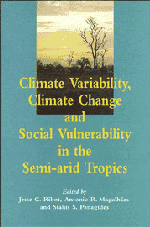Book contents
- Frontmatter
- Contents
- List of contributors
- Foreword by Tom Downing
- Preface
- List of abbreviations
- Introduction. Climate Variability, Climate Change and Vulnerability: Moving Forward by Looking Back
- PART I OVERVIEW
- PART II CLIMATE VARIATION, CLIMATE CHANGE AND SOCIETY
- PART III CLIMATE VARIABILITY AND VULNERABILITY: CAUSALITY AND RESPONSE
- 6 Drought Follows the Plow: Cultivating Marginal Areas
- 7 Amazonia and the Northeast: The Brazilian Tropics and Sustainable Development
- 8 Reducing the Impacts of Drought: Progress Toward Risk Management
- PART IV THE INTERNATIONAL CONFERENCE ON THE IMPACTS OF CLIMATIC VARIATIONS AND SUSTAINABLE DEVELOPMENT IN SEMI-ARID REGIONS (ICID)
6 - Drought Follows the Plow: Cultivating Marginal Areas
Published online by Cambridge University Press: 02 December 2009
- Frontmatter
- Contents
- List of contributors
- Foreword by Tom Downing
- Preface
- List of abbreviations
- Introduction. Climate Variability, Climate Change and Vulnerability: Moving Forward by Looking Back
- PART I OVERVIEW
- PART II CLIMATE VARIATION, CLIMATE CHANGE AND SOCIETY
- PART III CLIMATE VARIABILITY AND VULNERABILITY: CAUSALITY AND RESPONSE
- 6 Drought Follows the Plow: Cultivating Marginal Areas
- 7 Amazonia and the Northeast: The Brazilian Tropics and Sustainable Development
- 8 Reducing the Impacts of Drought: Progress Toward Risk Management
- PART IV THE INTERNATIONAL CONFERENCE ON THE IMPACTS OF CLIMATIC VARIATIONS AND SUSTAINABLE DEVELOPMENT IN SEMI-ARID REGIONS (ICID)
Summary
Almost a century ago the belief that ‘rain follows the plow’ was a popular one that accelerated population movements into the region now known as the American Great Plains. Until the mid-1800s, this region was considered a wasteland, useless for agriculture and human settlement, an inhospitable obstacle to settlers in search of the promised land in the western part of the North American continent.
At the same time that settlements crept westward after the Civil War in the 1860s, rainfall became more prevalent. Suddenly, what had previously been considered a barren waste was seen as a potential garden and a breadbasket for the eastern part of the country. Many attributed the increased rainfall to the effects of human settling activities, which included plowing fields, creating ponds, irrigating dry areas, and planting trees on what essentially had been a treeless grassland. The railroad companies and land speculators seized on this explanation to convince Easterners to move to the Midwest. The advertising campaigns successfully produced waves of immigrants who came to the sparsely populated plains seeking their fortunes (Webb 1931).
During the 1890s a severe, multi-year drought dispelled the rain follows the plow theory. Thousands of settlers abandoned their homesteads to seek livelihoods elsewhere. It seemed that much of the support for the assumption of a causal relationship between rain and population was simply exaggeration by the railroads and other land speculators, intent on selling land at higher prices than it was worth. Before long, people realized that dry and wet periods commonly alternated and that the region's first surge of settlers had accidentally coincided with the onset of a lengthy wet spell.
- Type
- Chapter
- Information
- Climate Variability, Climate Change and Social Vulnerability in the Semi-arid Tropics , pp. 125 - 128Publisher: Cambridge University PressPrint publication year: 1996
- 3
- Cited by



